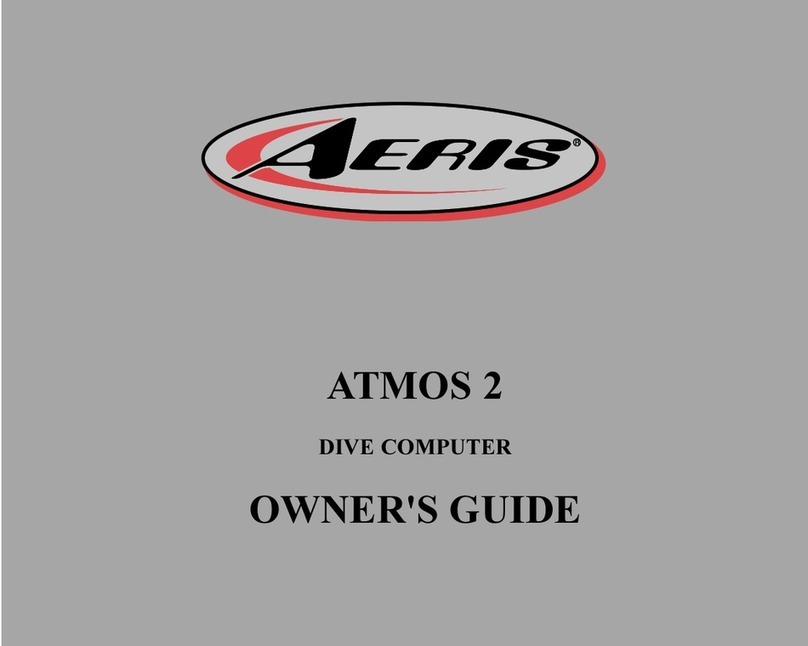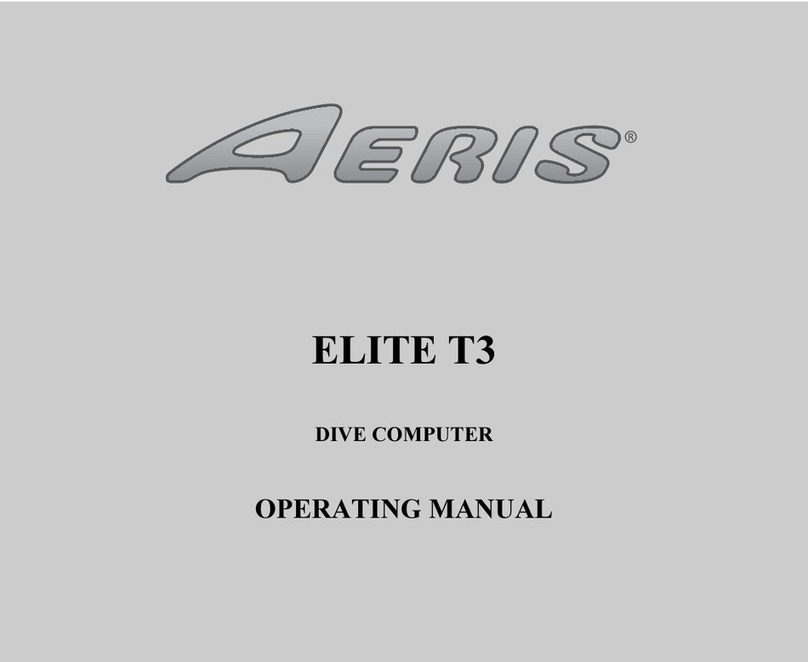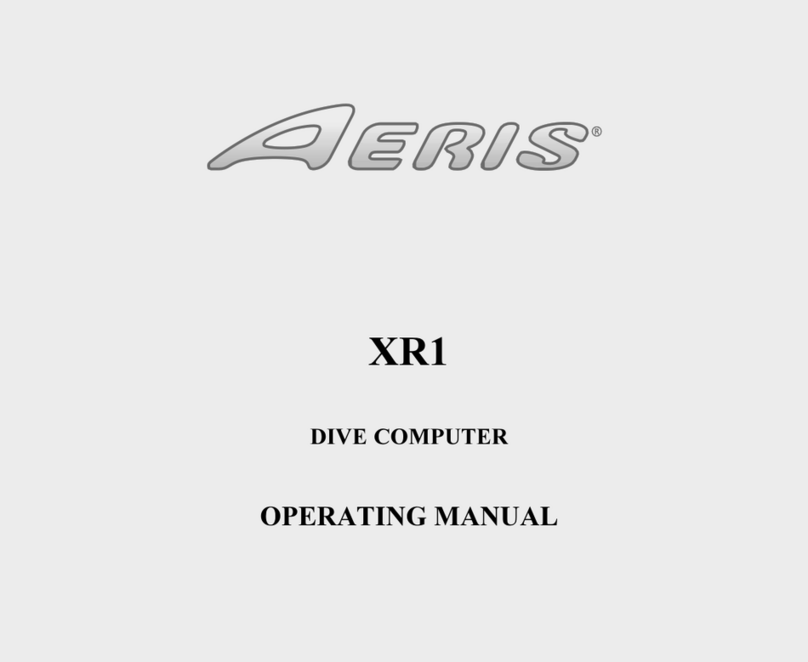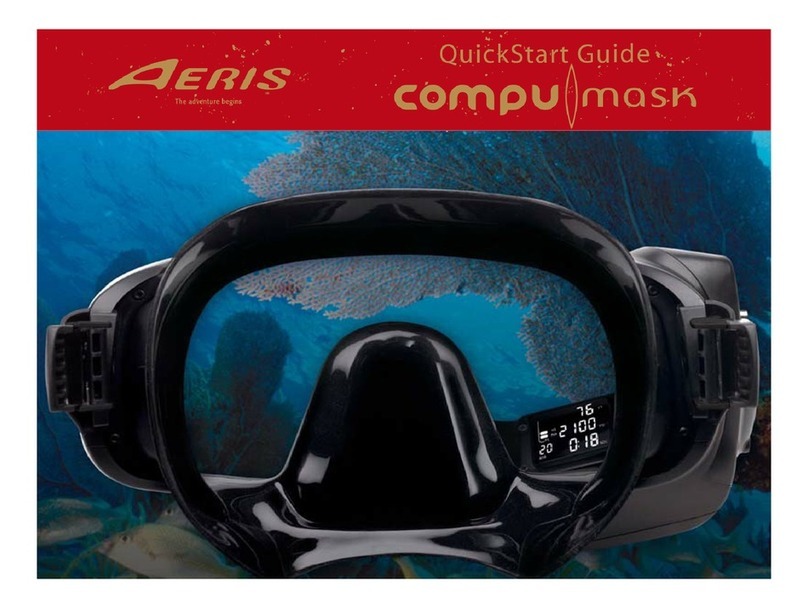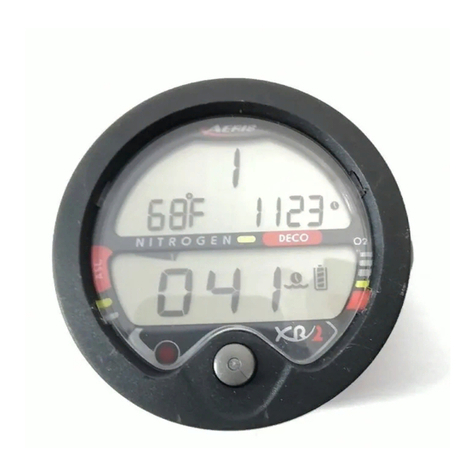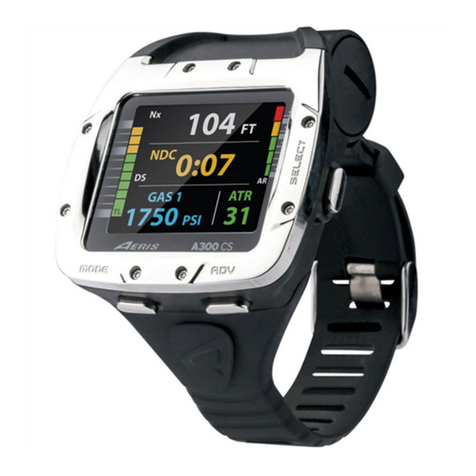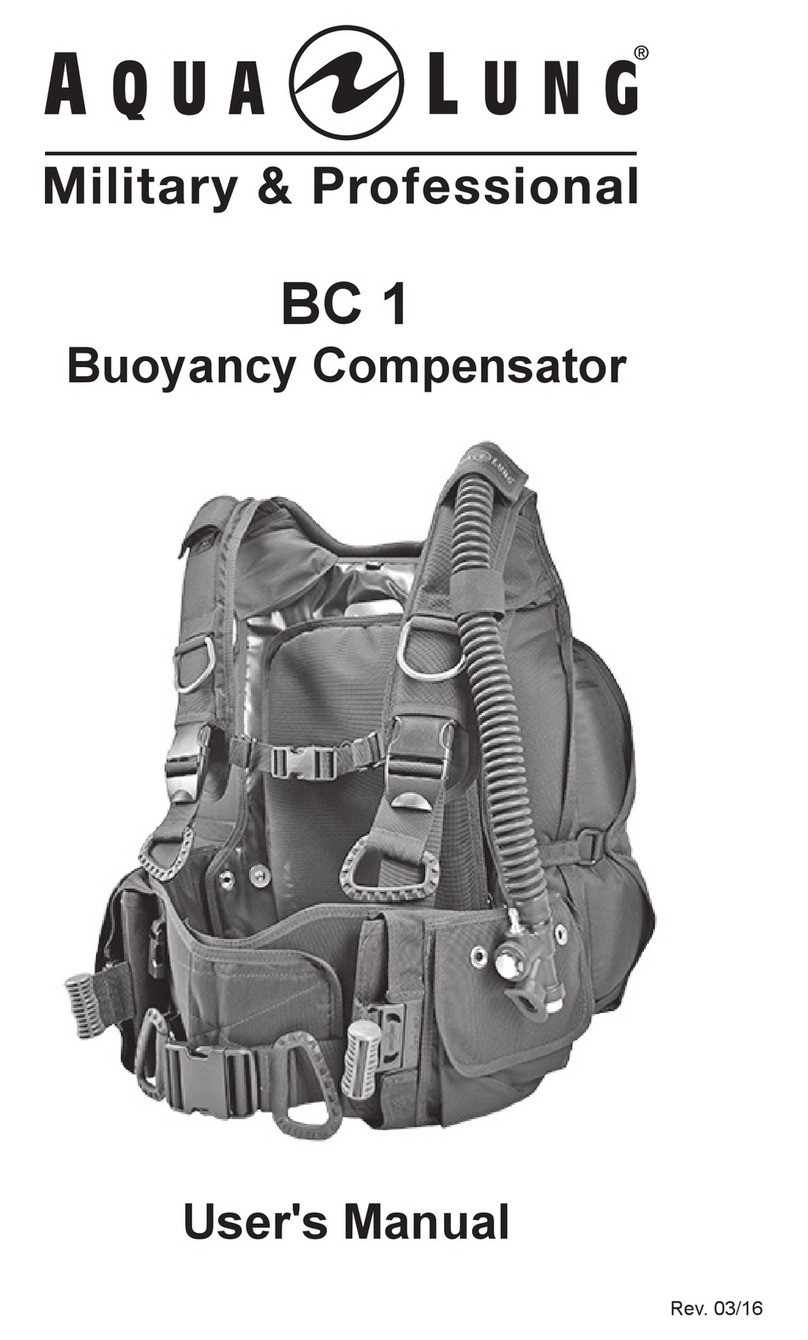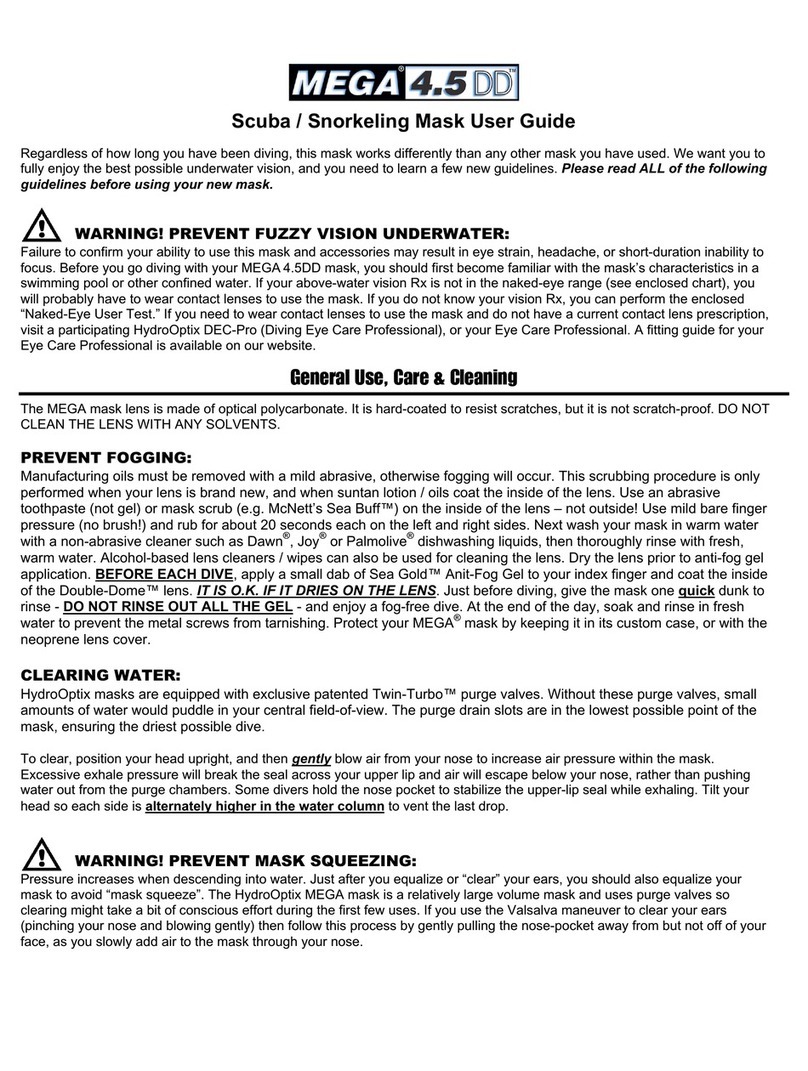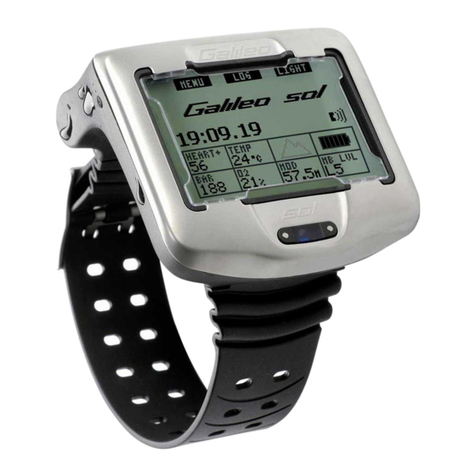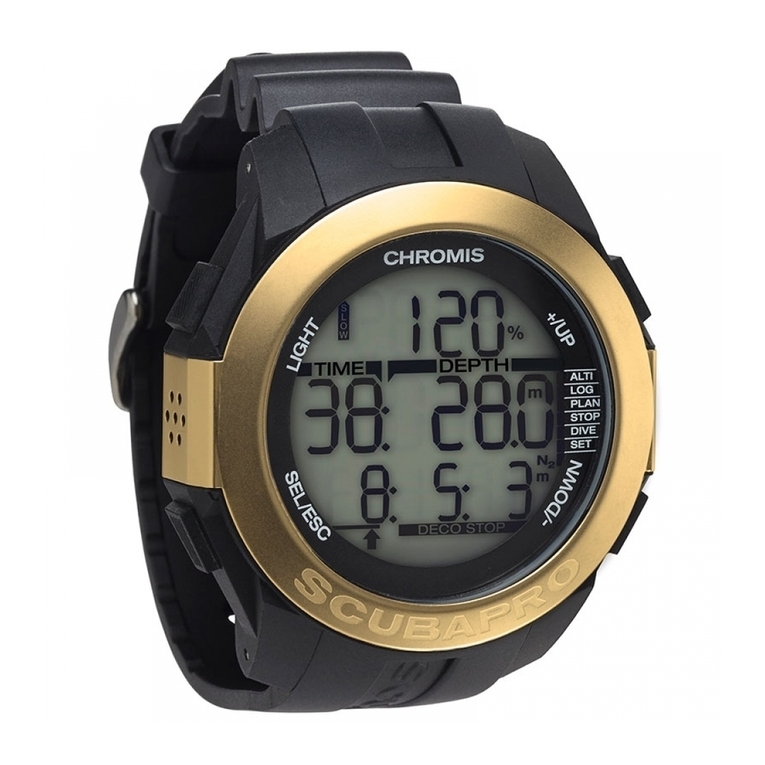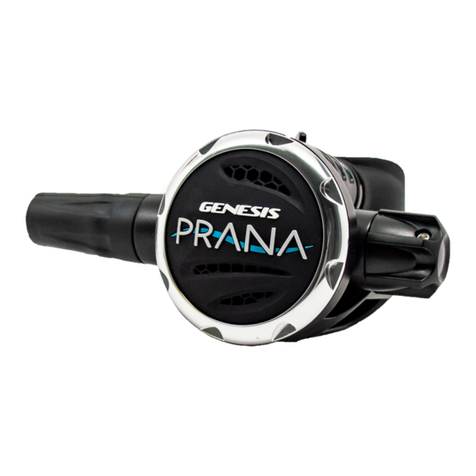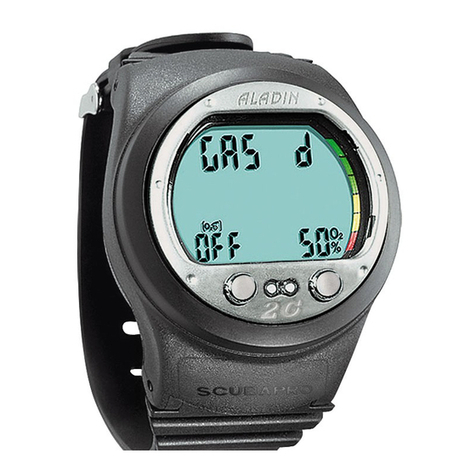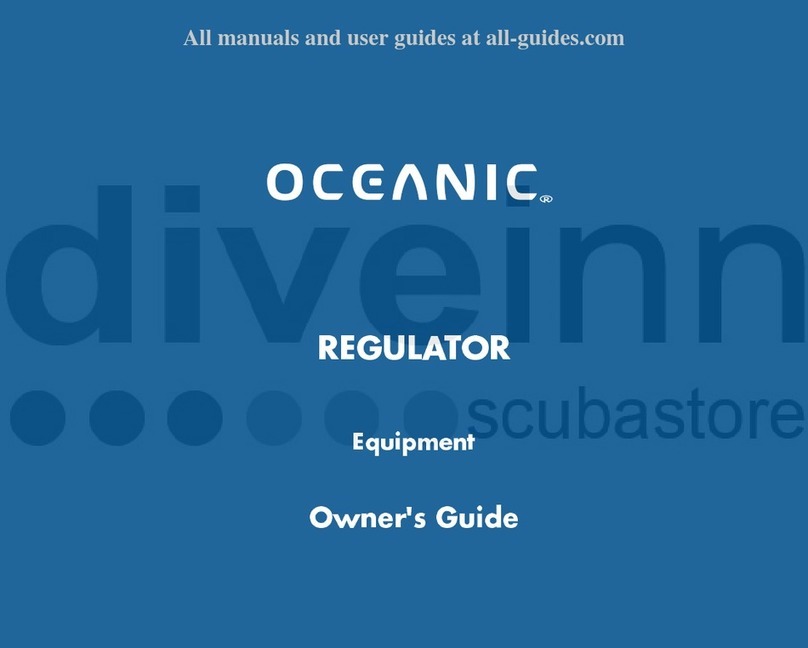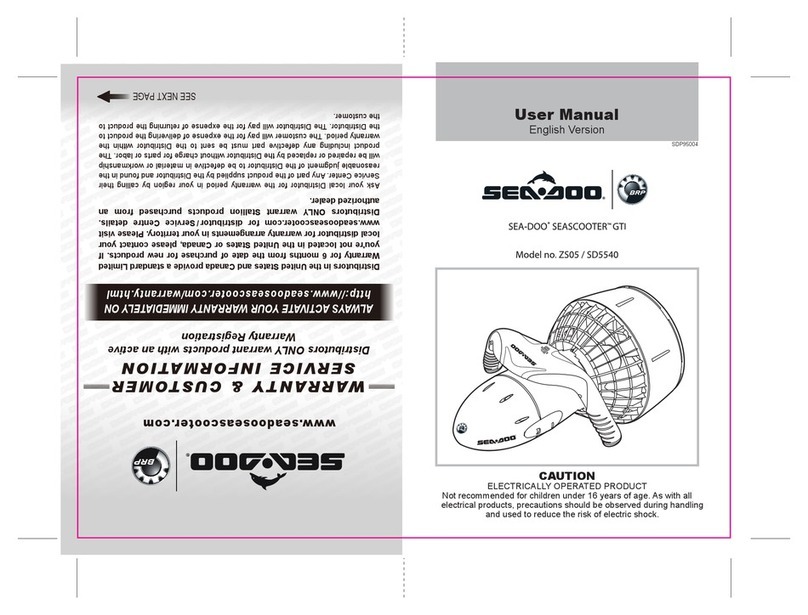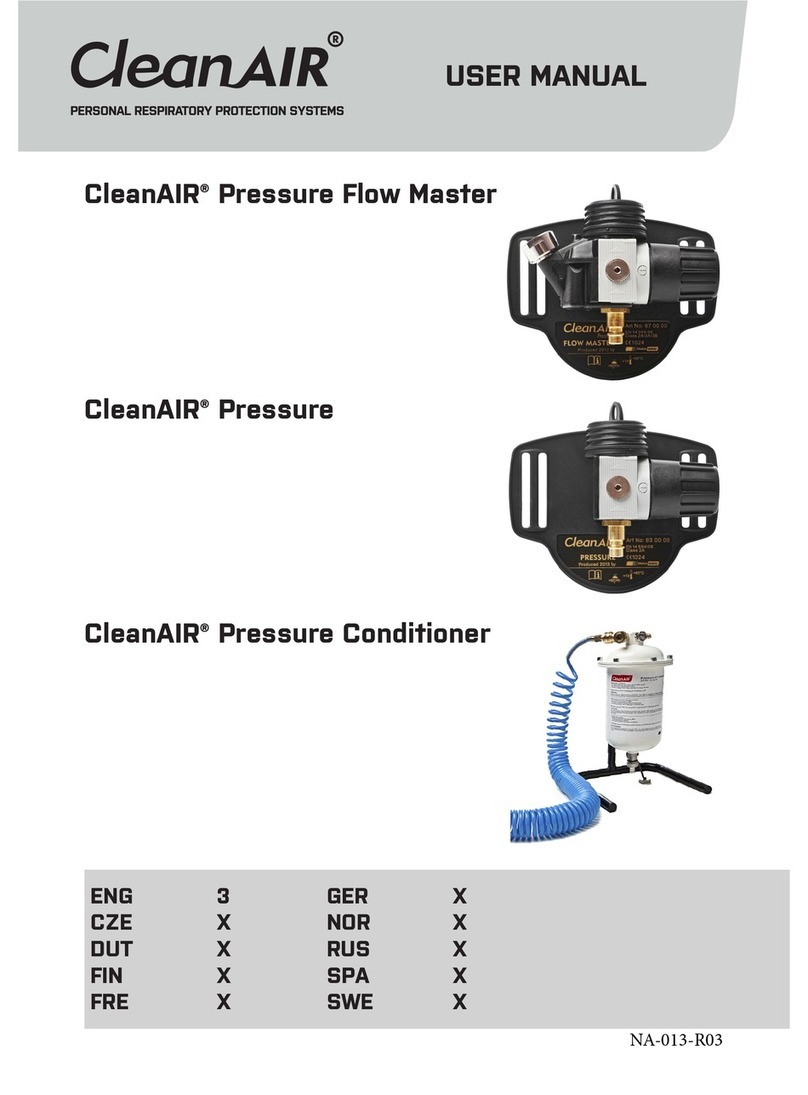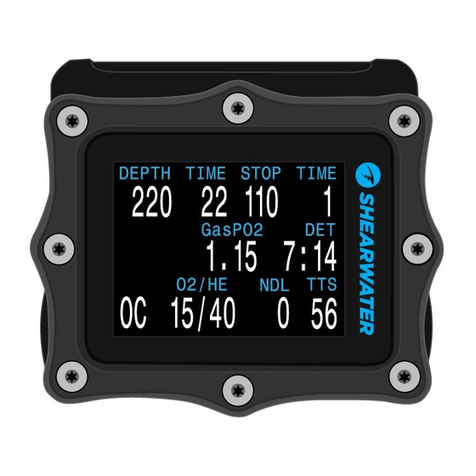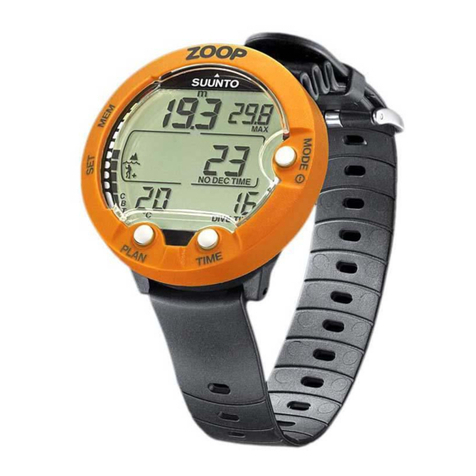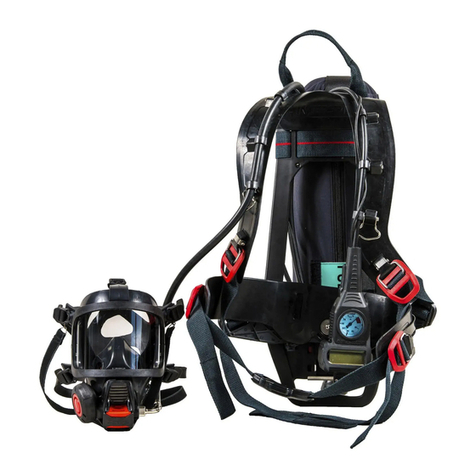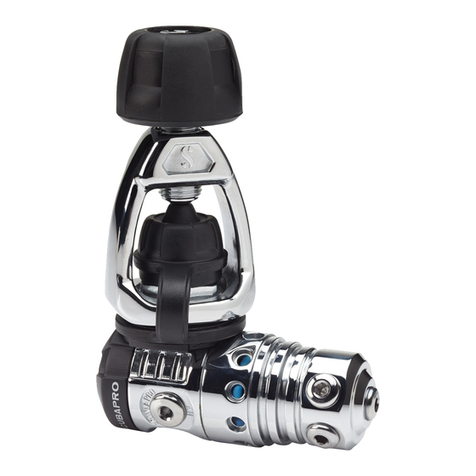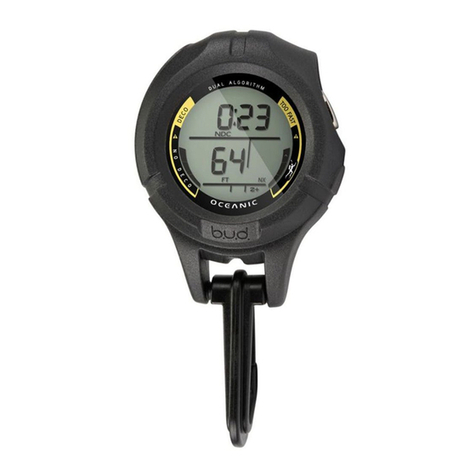Aeris ATMOS ai User manual

ATMOS
DIVE COMPUTER
OPERATING MANUAL
ai

2
LIMITED TWO-YEAR WARRANTY
For details, refer to the Product Warranty Registration Card provided.
COPYRIGHT NOTICE
This owners guide is copyrighted, all rights are reserved. It may not, in whole or in part, e copied, photocop-
ied, reproduced, translated, or reduced to any electronic medium or machine reada le form without prior con-
sent in writing from AERIS / 2002 Design.
ATMOS ai Operating Manual, Doc. No. 12-7153
© 2002 Design 2002
San Leandro, CA USA 94577
TRADEMARK NOTICE
AERIS, the AERIS logo, ATMOS ai, and the ATMOS ai logo are all registered and unregistered trademarks of
AERIS. All rights are reserved.
PATENT NOTICE
U.S. Patents have een issued, or applied for, to protect the following design features:
Dive Time Remaining (U.S. Patent no. 4,586,136), Data Sensing and Processing Device (U.S. Patent no.
4,882,678), and Ascent Rate Indicator (U.S. Patent no. 5,156,055). User Seta le Display (U.S. Patent no.
5,845,235) is owned y Suunto Oy (Finland).
DECOMPRESSION MODEL
The programs within the ATMOS ai simulate the a sorption of nitrogen into the ody y using a mathematical
model. This model is merely a way to apply a limited set of data to a large range of experiences. The
ATMOS ai dive computer model is ased upon the latest research and experiments in decompression theory.
Still, using the ATMOS ai, just as using the U.S. Navy (or other) No Decompression Ta les, is no guar-
antee of avoiding decompression sickness, i.e. the ends. Every divers physiology is different, and can
even vary from day to day. No machine can predict how your ody will react to a particular dive profile.

3
CONTENTS
WARRANTY ................................................................................................................................................................. 2
NOTICES ..................................................................................................................................................................... 2
DECOMPRESSION MODEL ....................................................................................................................................... 2
FEATURES AND DISPLAYS ............................................................................................. 7
CONTROL BUTTONS ................................................................................................................................................. 9
BAR GRAPHS ............................................................................................................................................................. 9
Nitrogen Bar Graph ................................................................................................................................................ 9
Oxygen (O2) Bar Graph ....................................................................................................................................... 10
Variable Ascent Rate ndicator ............................................................................................................................. 10
INFORMATIONAL DISPLAYS ................................................................................................................................... 11
Tank Pressure Display .......................................................................................................................................... 11
Depth Displays ...................................................................................................................................................... 11
Time and Date Displays ....................................................................................................................................... 12
Temperature Display ............................................................................................................................................. 12
AUDIBLE ALARM & LED .......................................................................................................................................... 13
BACKLIGHT .............................................................................................................................................................. 14
POWER SUPPLY ...................................................................................................................................................... 15
Battery ndicator ................................................................................................................................................... 15
Low Battery Condition .......................................................................................................................................... 15
FO2 MODE ................................................................................................................................................................ 16
FO2 50% Default .................................................................................................................................................. 17
DI E TIME REMAINING ........................................................................................................................................... 18
ACTIVATION AND SETUP .............................................................................................. 21
ACTI ATION .............................................................................................................................................................. 22
SURFACE MODE ...................................................................................................................................................... 23
SET MODES .............................................................................................................................................................. 24
ENTER NG SETT NGS -SET MODE #1 .............................................................................................................. 25
ENTER NG SETT NGS -SET MODE #2 .............................................................................................................. 29

4
PRE DIVE PLAN MODE ................................................................................................. 45
DI E PLANNER ......................................................................................................................................................... 46
DIVE MODES .................................................................................................................. 49
DI E MODE BAR GRAPHS ...................................................................................................................................... 50
CONTROL OF DISPLAYS ......................................................................................................................................... 50
NO DECOMPRESSION DI E MODE ....................................................................................................................... 51
DECOMPRESSION DI E MODE .............................................................................................................................. 54
IOLATION MODES .................................................................................................................................................. 56
Conditional Violation Mode ................................................................................................................................... 57
Delayed Violation Modes ...................................................................................................................................... 58
mmediate Violation Mode and Violation Gauge Mode ........................................................................................ 60
HIGH PO2 DI E MODE ............................................................................................................................................. 61
HIGH OXYGEN ACCUMULATION ............................................................................................................................ 64
USER SET DIGITAL GAUGE MODE ........................................................................................................................ 65
POST DIVE MODES ....................................................................................................... 67
POST DI E SURFACE MODE .................................................................................................................................. 68
TRANSITION PERIOD .............................................................................................................................................. 68
AFTER THE TRANSITION PERIOD (THE FIRST 2 HOURS) .................................................................................. 70
To access the Dive Planner (Plan Mode) ............................................................................................................. 70
To access the Time to Fly Countdown ................................................................................................................. 71
To access the Time to Desaturate Countdown .................................................................................................... 71
LOG MODE .......................................................................................................................................................... 72
AFTER THE FIRST 2 HOURS .................................................................................................................................. 75
DOWNLOADING DATA TO A PC .............................................................................................................................. 76
SIMULATOR (DEMO) MODE .......................................................................................... 77
CONTENTS (co ti ued)

5
RESET PROCEDURE ..................................................................................................... 84
GENERAL ....................................................................................................................... 85
CARE AND CLEANING ............................................................................................................................................. 86
INSPECTIONS AND SER ICE ................................................................................................................................. 87
BATTERY REPLACEMENT ...................................................................................................................................... 88
ALTITUDE SAMPLING/COMPENSATION ............................................................................................................... 93
SPECIFICATIONS ..................................................................................................................................................... 94
SERVICE RECORD ........................................................................................................ 99
CONTENTS (co ti ued)
Pay special atte tio to items marked with this WARNING
symbol.

6
LCD LAYOUT
Components:
a. Nitrogen Loading Bar Graph
b. Oxygen Accumulation Bar
Graph
c. Variable Ascent Rate ndicator
d. Select (bottom) Button
e. Advance (front) Button
f. Graphic - Demo Mode
g. con - Air Time Remaining
h. con - Set Alarm
i. con - Log Mode
j. Graphic - Depth
k. Graphic - Ascent Too Fast
l. con - Operating Mode
m. con - Time
n. con - Safety Stop
o. Graphic - Operating Mode
p. Graphic - Pressure
q. con - Ascend Arrow
con - Deco Ceiling Bar
con - Descend Arrow
r. Battery Consumption ndicator
s. con - Temperature
t. Graphic - Maximum Depth
a
b
c
d
e
r
s
f
m
g
hj
k
l
o
p
q
i
n
t

7
FEATURES and DISPLAYS
WARNING: Prior to divi g with the ATMOS ai, you must also read
a d u dersta d the AERIS Dive Computer Safety & Refere ce
Ma ual, Doc. No. 12-7203, which provides Importa t War i gs a d
Safety Recomme datio s as well as ge eral product i formatio .

8
WELCOME TO AERIS !
AND
THANK YOU FOR CHOOSING THE ATMOS ai !
Your ATMOS ai presents the information that you need before, during, and after your air (or nitrox)
dives using a combination of easy to read displays and identification icons. It can also be set to
operate simply as a digital depth gauge/timer.
This instructional guide is intended to help you become familiar with the functions and features
available and show you examples of displays that you could expect to see in the various opera
tional modes. Ensure that you read through this complete Owner's Guide.
Remember that the rules you learned in your basic scuba certification course(s) still apply to the
diving you will do while using a dive computer some will become even more important. Tech
nology is no substitute for common sense, and a dive computer only provides the person using it
with data, not the knowledge to use it.
Since the ATMOS ai can be used when diving with either Air or Nitrox, the term Breathing Gas is
used in this manual.
Breathing Gas is the gaseous mixture breathed during a dive.
Air is a breathing gas that contains approximately 21% oxygen and 79% nitrogen (nature's
common nitrogen oxygen mixture).
Nitrox is a nitrogen oxygen breathing gas that contains a higher fraction of oxygen than air
(>21%).

9
CONTROL BUTTONS
The two Control Buttons allow you to select display options, access specific information when
you want to see it, and activate the Unit and the Backlight.
The Front button is named Advance (Fig. 1a) and the Bottom/Side button Select (Fig. 1b).
BAR GRAPHS
Nitroge Bar Graph
The Nitrogen Bar Graph (Fig. 1c) represents tissue loading of nitrogen, showing your relative no
decompression or decompression status. As your depth and elapsed dive time increase, segments
will add to the Graph, and as you ascend to shallower depths, the Bar Graph will begin to recede,
indicating that additional no decompression time is allowed for multilevel diving.
The Nitrogen Bar Graph monitors 12 different nitrogen compart
ments simultaneously and displays the one that is in control of your
dive. It is divided into a green No Decompression (normal) zone, a
yellow Caution zone (also No Decompression), and a red Decom
pression (danger) zone.
While you cannot provide a guarantee against the occurrence of de
compression sickness, you may choose your own personal zone of
caution based upon age, physique, excessive weight, etc., to reduce
the statistical risk.
Fig. 1 - Buttons and NiBG
a
bc

10
Oxyge Accumulatio Bar Graph (O2BG)
The O2 Bar Graph (Fig. 2a) represents oxygen loading, your rela
tive oxygen tolerance dosage (OTU), showing the maximum of ei
ther per dive accumulated oxygen, or 24 hour period accumulated
oxygen. As your accumulation increases during the dive, segments
will add to the Bar Graph, and as loading decreases, it will begin to
recede, indicating that additional exposure is allowed.
NOTE: Displays associated with oxyge a d the
O2 Bar Graph will o ly appear if FO2 has bee set
at a value other tha 'Air' (e.g., a umerical value).
Variable Asce t Rate I dicator (VARI)
The Variable Ascent Rate Indicator (Fig. 2b) provides a visual rep
resentation of ascent speed (i.e., an ascent speedometer). Green is
a 'normal' rate, yellow a 'caution' rate, and red is 'Too Fast'. The
segments of the Variable Ascent Rate Indicator represent 2 sets of
speeds which change at a reference depth of 60 feet (18 meters).
Refer to the chart for segment values.
WARNING: At depths greater tha 60 feet (18
meters), asce t rates should ot exceed 60 feet per
mi ute (18 mpm). At depths of 60 feet (18 meters)
a d shallower, asce t rates should ot exceed 30
feet per mi ute (9 meters per mi ute).
Fig. 2 - O2BG and VAR
Variable Ascent Rate ndicator
Deeper than 60 feet (18 m)
Segments Ascent Rate =
Displayed FPM MPM
0 0-20 0 - 6
1 21-30 6.5-9
2 31- 0 9.5-12
3 1-50 12.5-15
51-60 15.5-18
5 >60 >18
60 feet (18 m) & Shallower
Segments Ascent Rate =
Displayed FPM MPM
0 0-10 0 - 3
1 11-15 3.5- .5
2 16-20 5-6
3 21-25 6.5-7.5
26-30 8-9
5 >30 >9
a
b

11
INFORMATIONAL DISPLAYS
Each numeric and graphic display represents a unique piece of information. It is imperative
that you understand the formats, ranges, and values of the information represented to avoid
any possible misunderstanding that could result in error.
Ta k Pressure Display
Tank pressure is displayed numerically in the lower window (Fig. 3a). Values of pressure are dis
played from 0 PSI (BAR) up to 5000 PSI (352 BAR) in increments of 10 PSI (.5 BAR).
Depth Displays
During a dive, the Current Depth display (Fig. 3b), indicates depths from 0 to 330 feet (99.9
meters) in 1 foot (.1 meter) increments. The Ma imum Depth reached during that dive will be
displayed in the upper window (Fig. 3c).
When the unit is set to operate as a Digital Depth Gauge/Timer
(referred to as User Set Gauge Mode), the Depth Display range
is 'extended' to 399 feet (120 meters).
At depths greater than 99.9 meters, it will indicate metric values
in increments of 1 meter.
During a Decompression Dive, the required Ceiling Stop Depth is
displayed instead of Max Depth. Max Depth can then be viewed
by pressing the Advance (Front) button.
Fig. 3 - Pressure and Depth
c
a
b

12
Time a d Date Displays
Time displays are shown in hour:minute format (i.e., 1:22 represents 1 hour and 22 minutes, not
122 minutes!). The colon that separates hours and minutes blinks once per second when the dis
play is indicating real time (e.g., Elapsed Dive Time), and is solid (non blinking) when times are
calculated projections (e.g., Time to Fly).
Due to the importance of the information it presents, the Main Time display is configured with
the largest segments of the LCD in the upper window (Fig. 4a). A second time display is located
in the lower right portion of the window (Fig. 4b). Both displays are identified by a clock icon.
Time of Day can be set for 12 hour format (AM/PM) or 24 hour format.
Date is displayed in the lower screen only to identify dive data while it is viewed in the Log
Mode.
When Units of Measure are set for 'Imperial', the Month appears to
the left of Day. When set for Metric, the Month appears to the
right of Day.
Temperature Display
Ambient Temperature is displayed in the upper window (Fig. 4c)
while in the Surface Mode and can be viewed as part of an Alter
nate Display when the Advance (Front) button is pressed while in a
dive mode. If the Temperature exceeds a value of '99', 2 dashes
( ) will be displayed on the screen until the unit's temperature
decreases to '99'.
Fig. 4 - Time and Temperature
a
b
c

13
NOTE: The I formatio al Displays are described i detail as the various op-
erati g modes they appear i are prese ted throughout this ma ual.
AUDIBLE ALARM
When warning situations activate the Alarm, the unit will emit a continuous beeping tone for 10
seconds, or until the situation is corrected, or it is acknowledged by pressing the Advance (Front)
button for 2 seconds. If acknowledged by the user and the situation corrected, the Alarm will
sound again upon reentry into the warning situation, or entry into another type of warning situa
tion.
A red LED Warning Light located on the upper left portion of the module is synchronized with
the Audible Alarm and will indicate an Alarm when the unit emits a tone. It will be OFF when
the Alarm is acknowledged, or Set OFF (a user setting).
Warning situations that will sound the Alarm, if it is turned ON (a user setting), include -
Entry into Decompression Mode
PO2 => than the Max PO2 Alarm (a user setting), or => 1.60 ATA.
Descent deeper than the Max Depth Alarm (a user setting).
Nitrogen Bar Graph Alarm (a user setting).
Dive Time Remaining Alarm (a user setting).
Elapsed Dive Time Alarm (a user setting).
O2 Accumulation => allowable per dive limit, or limit for a 24 hour period.
Ascending above a required Decompression stop depth for < 5 min. (Conditional Violation).
Ascent rate exceeds 60 fpm (18 mpm) if > 60 ft (18 m), or 30 fpm (9 mpm) if <= 60 ft (18 m).
Turn Pressure Alarm (a user setting).
End Pressure Alarm (a user setting).

14
During the following situations, the 10 second continuous tone will be followed by a 5 second
steady beep that will not turn off when acknowledged, even if it was user Set OFF -
Ascending above a required Decompression stop depth for more > 5 min. (Delayed Violation).
Decompression requires a ceiling stop depth => 70 FT (18 M).
Being on the surface for 5 minutes after a Conditional Violation (Permanent Violation).
A single short beep (which cannot be disabled) is emitted - after the Diagnostic check, upon
automatic return to Surface Mode from Simulator Mode, upon completion of a fast battery change
with calculations/settings saved, and upon change from Delayed to Full Violation after that dive.
BACKLIGHT
To activate the Backlight while in the Surface Mode or during a dive
press the Select (Bottom) button.
The screens (upper and lower) will be illuminated for button depression time plus 3, 5, or 7
seconds (a user setting). Press and release the button again to activate as desired.
The Backlight does not operate during a Low Battery condition.
NOTE: AERIS recomme ds that you always carry primary a d backup dive
lights whe co ducti g dives that could i clude low light situatio s.

15
POWER SUPPLY
The ATMOS ai utilizes one (1) 3 volt, CR2450 Lithium Battery that should provide from 300
dive hours of operation if you conduct one 1 hour dive each time the unit is activated, to over 600
dive hours of operation if you conduct two or more dives each time the unit is activated.
Battery I dicator
A Battery Indicator (icon) provides an indication of Battery condition. The Battery Indicator
will be displayed during Surface Mode (Fig. 5a). It will not be displayed during Dive Modes.
Low Battery Co ditio
Voltage level is checked upon activation and every 10 minutes during operation.
Once 75% of full power is consumed, the Indicator will display only one bar and the icon will
flash once per second as a warning that the Battery is to be changed prior to conducting any fur
ther dives with the unit.
If a Low Battery Condition exists when the unit is activated (by pressing the button), the Bat
tery icon will appear flashing once per second for 5 seconds followed by shutdown of the unit.
If the button is not pressed to activate the unit prior to a dive, and
a Low Battery Condition exists, the Low Battery icon will appear
flashing as a warning upon descent past 4 feet (1.2 meters). No
other information will be displayed and the unit will not enter
Dive Mode.
If the unit did not display the Low Battery icon 'prior to' entering
the Dive Mode, and a Low Battery Condition occurs during the
dive, there will be sufficient Battery power to maintain unit op
eration for the 'remainder of that dive'. The Low Battery icon will
appear flashing upon surfacing when Surface Mode is displayed. aFig. 5 - Battery ndicator

16
FO2 MODE
After Activation, the ATMOS ai will operate as an Air computer
without displaying information associated with oxygen calcula
tions, unless it is set for a percentage of oxygen (FO2) other than
Air (numerical value between 21 and 50 %).
NOTE: Setti g FO2 is described o Page 27.
When set with an FO2 value of 'Air' (Fig. 6), the ATMOS ai will
perform calculations the same as if FO2 were set for 21% oxygen,
internally accounting for oxygen loading for any subsequent
Nitrox dives. However, oxygen related displays, warnings, and the
O2 bar graph will not appear on the display for that dive, or subse
quent dives, unless FO2 is set for a numerical value (21 50).
Once a dive is made with the unit set as a nitrox computer (FO2 set
for a numerical value), the unit cannot be programmed to operate
as an 'Air' computer until 24 hours after the last dive. 'Air' will not
be displayed as an option in the FO2 Mode. However, you can set
FO2 for 21% for use with Air.
When FO2 is set at a value of 21% (Fig. 7), the unit will remain
set at 21% for subsequent nitrox dives until FO2 is set to a higher
value, or until it automatically turns off and is reactivated.
Fig. 6 - FO2 Air
Fig. 7 - FO2 of 21%

17
WARNING: The perce tage of oxyge (FO2) i the
itrox mix bei g used must be set 'before each'
itrox dive, u less the FO2 50% Default feature has
bee tur ed OFF.
FO2 50% Default
If the Default is set to ON and FO2 is set to a value 'greater than
21%', the FO2 set point value will automatically revert to 50% 10
minutes after that dive (Fig. 8). The Maximum Depth that can be
achieved with a PO2 of 1.60 ATA will also be displayed.
FO2 must therefore be reset for each repetitive nitrox dive, or the
value will automatically 'default' to 50(%) and the dives will be
calculated based on 50% O2 (50% nitrogen) for oxygen calcula
tions and 21% O2 (79% nitrogen) for nitrogen calculations.
WARNING: If you surface for greater tha 10 mi -
utes duri g a dive, a subseque t desce t will be
co sidered a ew dive a d FO2 must be reset.
If the Default is set to OFF, the FO2 value for repetitive dives re
mains the same (Fig. 9) until the set point is manually changed.
WARNING: Eve if the Default is set to OFF, the
FO2 set poi t should be 'verified' to match the FO2
i the itrox mix bei g used before each itrox dive.
Fig. 8 - FO2 Default ON
Fig. 9 - FO2 Default OFF

18
DIVE TIME REMAINING
One of the most important pieces of information on Aeris dive computers is the 'Dive Time Re
maining numeric display'. The ATMOS ai constantly monitors no decompression status, oxygen
accumulation, and breathing gas consumption rate.
The Dive Time Remaining* display will indicate the time that is more critical for you at that
particular moment (i.e.; whichever time is the least amount available). The specific time be
ing displayed is identified by the No Decompression Dive Time icon, the O2 Time icon, or Tank
icon. (* This unique feature has been granted U.S. Patent No. 4,586,136.
No Decompressio Dive Time Remai i g
No Decompression Dive Time Remaining is the maximum amount of time that you can stay at
your present depth before entering a decompression situation. It is calculated based on the amount
of nitrogen absorbed by hypothetical tissue compartments. The rates each of these compartments
absorb and release nitrogen is mathematically modeled and compared against a maximum allow
able nitrogen level. Whichever one is closest to this maximum
level is the controlling compartment for that depth. Its resulting
value will be displayed numerically (Fig. 10a) along with the No
Decompression Dive icon and graphically as the Nitrogen Bar
Graph (Fig. 10b).
As you ascend from depth following a dive that has approached
the no decompression limit, the Nitrogen Bar Graph will recede as
control shifts to slower compartments. This is a feature of the de
compression model that is the basis for multilevel diving, one of
the most important advantages that Aeris dive computers offer.
Fig. 10 - No Decompression
Dive Time Remaining
a
b

19
The no decompression algorithm is based upon Haldanes theory using maximum allowable nitro
gen levels developed by Merrill Spencer. Repetitive diving control is based upon experiments de
signed and conducted by Dr. Ray Rogers and Dr. Michael Powell in 1987. Diving Science and
Technology® (DSAT), a corporate affiliate of PADI®, commissioned these experiments.
Oxyge Accumulatio Time Remai i g
Oxygen accumulation (exposure) during a dive, or 24 hour period, appears graphically as the
Oxygen Accumulation (O2) Bar Graph (Fig. 11a). As time remaining before reaching the oxygen
exposure limit decreases, segments are added to the O2 Bar Graph.
When the amount of time remaining before reaching the oxygen limit becomes less than the No
Decompression Dive Time Remaining, calculations for that depth will be controlled by oxygen.
Oxygen Time Remaining will then appear as the main numeric time display (Fig. 11b) as signi
fied by the O2 Time icon appearing on the display. As oxygen accumulation continues to in
crease, the O2 Bar Graph will enter the yellow Caution Zone.
Air Time Remai i g
The ATMOS ai calculates Air Time Remaining using a patented al
gorithm that is based a diver's individual breathing gas consump
tion rate and current depth. Tank Pressure is measured once each
second and an average rate of consumption is calculated over a 60
second period. This Rate of Consumption is then used in conjunc
tion with a knowledge of the depth dependence to predict the
breathing gas required for the diver to make a safe controlled as
cent including any required decompression stops. Fig. 11 - O2 Accumulation
Dive Time Remaining
ab

20
Breathing Gas Consumption and Depth are continuously monitored and Air Time Remaining re
flects any change in circumstances. For example, when a buddy starts breathing from your octo
pus or you suddenly find yourself swimming against a strong current and begin breathing more
rapidly, the ATMOS ai will recognize the change and adjust the Air Time Remaining accordingly.
Remember, the Air Time Remaining is the time you can remain at the present depth and still
safely surface with the tank pressure reserve that you selected during setup (End Pressure Alarm
Set Point).
When Air Time Remaining indicates zero (Fig. 12a), you should immediately initiate a controlled
ascent while monitoring your tank pressure. However, there is no reason to panic, the ATMOS ai
has allowed for the breathing gas necessary for a safe ascent including any emergency decompres
sion stops required.
Example:
You set the End Pressure Alarm for 300 PSI (20.5 BAR)
You are at a depth of 60 feet (20 meters)
Air Time Remaining decreases to 0:00
You ascend at a maximum rate of 30 fpm (10 mpm)
You surface with 300 PSI (20.5 BAR) pressure still in your tank
Fig. 12 -Air Time Remaining =
0:00
a
Table of contents
Other Aeris Diving Instrument manuals

